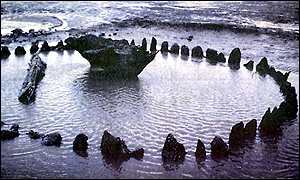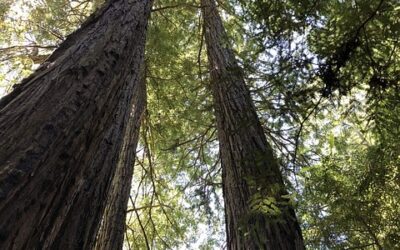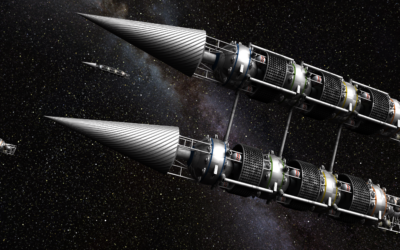Seahenge, Norfolk, England, 4000 BC
Robert Duncan-Enzmann
5900 to 3750 – The warm Atlantic I, II, III, and IV Grand Climate Optimum era. Global temperatures during this time were considerably warmer than today. Humankind makes great strides in warm, comfortable weather. This was the golden age for humanity to explore. A great intercontinental utility of megalithic observatories for agriculture and navigation was constructed over millennia. With this utility, the megalithic mariners sailed the oceans around the world and measured the circumference of the Earth.
6000 – 5900 – Cochran 100-year glaciation is triggered by the Hudson Bay Slush-Out, the enormous lakes breaking through the glacial dam flood the North Atlantic with icebergs. It raises global sea level such that the flooding of the English Channel and expansion of the North Sea floods the northern plains. Dogger Banks are first islands, then submerged. The 5600 BC flooding of the Black Sea and Baltic Sea all occur over a few hundred years.
RDE: In 6000 BC, there are evidences of pre-LBK and early LBK Atlantis 1a Old European writing, seemingly a combination of symbols and phonetics sequenced linearly.
5900 to 5600 – Atlantic Ia as identified by Danish pollen zone VIIa.
5800 – Immediate pre-LBK and Early LBK Silviculture is evidenced by abnormally great quantities of local hazel pollen. Hazel is a common second growth in fire-glades created by burning-out forests during dry seasons. Hazel nuts are an excellent starchy food.
Note: RDE – it suggests fire-glade Silviculture, along with planting nuts in the cleared land was practiced early as the Solutrean.
5795 to 5600 – Atlantic Ib
5600 – 5500 – Ostend I Cold Drought ends Atlantic I. Ostend Ib: Mount Manaza Volcano, North America, detonates leaving Crater Lake. Inter-Atlantic I / II cold drought glacial expansion*.
RDE: *Possibly due to Hudson Bay Slush-Out dust storms.
5600 to 4500 – LBK Linear band ceramic (Linear Ware) culture of BC Atlantic II centuries is the first widespread Neolithic culture of Temperate Europe. Its origins are the small farms of 5900 BC Atlantic I.
LBK Linear Ware Culture, 5000 BC
LBK villages were sited on loess-lands they raised: wheat (Triticum monococcum, T. dicoccon, T.aestivum, T.spelta); barley (Hordeum vulgare]) millet (Panicum miliaceum); rye (Secale cereal); oats (Avena sativa); flax (Linum usitatissimum), peas (Pisum sativum); grass peas (Lathrus sativus); lentils (Lens culinaris); poppies (Papaver setigerum and somniferum- in the eastern areas) hemp (cannabis); cherries (Prunus and Cornus mas); acorns; hazelnuts; hay, and silage for winterfeed fodder.
LBK houses were 60 to 150 feet long. Animals were kept in the northerly side, people lived in the sunnier southern side. Dogs and cats were kept, snakes were encouraged, as were barn owls. Dogs warn of animals and strangers. The other creatures control rodents which consume and befoul stored grains, nuts, and acorns. Sheep, goats, geese, ducks, pigs, cattle and horses were kept.
Wild animals hunted included: red deer, roe deer, swine, wild horses, rabbits, beavers, hamsters, and occasionally bear, wolf and foxes. Illumination was with oil lamps. Textiles included linens, wool, and linsey-woolsey which was popular in the United States in remote areas until the early 1900s.
LBK settlements were often ditched and occasionally palisaded. Certainly “cattle rustling” would have occurred.
LBK people and culture are likely ancestral to Europe’s Indo Germanic Celtic and Nordic populations. When measurements of mitochondria of SRY genetics and other such factors are made, these evidences, together with physical anthropology, will finally identify the Indo-Germanic Celts, it’s Nordics, and the general Indo-European homeland.
Germany’s LBK Linear band ceramic (Linear Ware) culture of 5600 to 4500 BC Atlantic Ii Centuries, is the first civilization known to have constructed a large central observatory, then, with observations made there, expand a continent-wide Neolithic utility. 4700 to 4300 BC: STK Observatory, descended directly from Atlantic I, 5796 to 5600 BC.
5500 – Proto Goseck Site Observatory Germany
5500 to 5200 – Pre-Cucuteni II Sites: Bernashevka and Okopi
5480-4550 – Yasinovatka
5400 – Brzesc Site Poland
5370 – 3970 – Dnieper-Donetz II Culture; Nikol’skoe
5300 – 4300 – Goseck Site Observatory Germany (origin of megalith yard & continental-European salt lines)
RDE: Observation show that stellar motion changes with azimuth. How can we correct this when building observatories? By drawing the proper ellipse.
Note: M. Gimbutas considers 6000 to 5300 BC the Early Phase of Old European Script and 5300 to 4000 BC the Climactic Phase of Old European Script.
RDE dates of 5500 to 4200 BC are ventured instead, suggesting the LBK culture was literary, and knowledge of writing was widespread.
5260-5000 – Dereivka I
5200 to 4550 – Tripolye A Sites Sabatinovka I, Luka-Vrublevetskaya, Grenovka
5210-4350 – Osipovka
5000 – Brodgar Ring Site & Skara Brae Site. Earliest settlers’ wooden posts and Neo-stones; Goseck Observatory, Germany. Agricultural utility
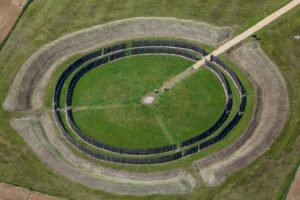
Goseck Observatory, Germany
RDE: I back-date:
1) the continent-wide standard megalith yard’s origin discovered by Alexander Thom
2) 366-degree megalith circle
3) definition of a temporal second
4) definition of a megalith arc second
5) measured number of sidereal days (number of times the Earth turns about its axis) in a year as 366.2564
6) measured number of mean solar days (number of sunrises) in a year. It certainly seems that Alan Butler has demonstrated that knowledge to be very important to navigators; which sidereal day it is, is easily found with the Phaistos disc.
RDE: Use of pendulums to measure motion of the celestial sphere, then translating this into standard measures of distance, time, weights, and volumes is lucidly described in Uriel’s Machine.
The LBK agriculturalists Goseck at Carnac and associated observatories were conceived and started during Atlantic I, fully operational during Atlantic II, then during Atlantic II and Atlantic III must have originated the measurements 1 to 6 listed above, brilliantly expanded on by the Grooved-Ware agricultural and world-ocean voyaging culture at New Grange and Bryn Celli Ddu.
Without observations 1 to 6, the mariner’s observatories such as Newgrange, Bryn Celli Ddu, etc. could not have been built.
To engineer navigators’ observatories, knowledge of how to number:
1- solar years
2- sidereal years
3- lunar years and planetary motions are necessary.
We may reasonably suggest that this was done at Goseck observatory. An excellent technique for doing this is suggested by the 2200 BC Minoan Phaistos Disc.
Phaistos Disc, 1000-2000 BC
RDE: Observation Longitude may be accurately measured using Venus and even the moon or Mercury as clocks; however, to do this the navigator must know exactly what day of the sidereal year it is. It’s easy to lose count. How may this be done with comfortable accuracy? Commensurable counts must be available. The Phaistos Disc’s spiraled sides certainly seem planned to easily reference, and accurately know the sidereal day of the year.
BC, but it must be based on sciences formulated between 5900 to 4200 BC.
Its brilliant calendric identification of sidereal day amidst mean solar days is a routine, while the many symbols detail cargo preparation, storage, nature of cargos, harvest, fabrication, and shipping times, which are not routine.
Count 123 symbols on side A. Relate to proper symbol on side B. Repeat for 2nd symbol on side A. Relate to side B and repeat 123 counts on A for 119 symbols on B. It’s a total of 14,637 days. This totals 40 years of 366 days. Three dots indicate one day be subtracted every 402 days, keeping solar and sidereal calendars coincident for about 3000 years.
The Phaistos Disc addresses not only navigation, but commerce on Crete such as weaving, and metallurgy prepared for its maritime trade. Phaistos is in southern Crete not far from Port Avaris. Avaris in Egypt was likely founded 3500 –3100 BC by bad-weather-impelled Megalith mariners from the Baltic, North Sea, and Atlantic. They, as Palasgians, likely built both Avaris, Crete then Avaris, Egypt as trading centers with Egypt’s Nilot civilization, which was unified 3100 BC as it emerged from centuries of war with drought-impelled Semites from the Arabian Peninsula.
Phaistos Crete is a metallurgical center, textile traders center, and foodstuffs market.
Avaris, during the Hyksos-Hebrew occupation ending with Ramses III Hyksos wars, then Exodus expelling Jews, remains the major Eastern Mediterranean trade center and a complex of fortifications, from which Egyptians are dominated and ruled.
4700 to 4300 – Atlantic II, STK-Observatory, descended directly from Atlantic I (5796 to 5600); Germany’s LBK Linear band Ceramic (Linear Ware) culture of 5600 to 4500 BC Atlantic II Centuries is the first civilization known to have constructed a large central observatory, then, with observations made there, expanded a continent-wide Neolithic utility.
Note: 4700 to 4300 BC STK Observatory descended directly from Atlantic I, 5796 to 5600 BC.
4200 – Inter-Atlantic III / IV, Kurgan II
Phonetic Scripts chart:
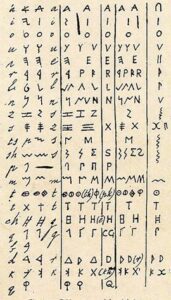
Left-to-right: 1, 2 Phoenician, 3, 4 Iberique, 5, 6 Greek, 7 Roman, 8, 9 Iberian, 10, Old-Iberian, derived from 5500 to 4200 BC Old European phonetic script. Last column: Primitive Old Celt Iberian deriving from Old European phonetic script widely used on megaliths.
Pre-Dynastic Egyptian Hieratic Script seems to derive from Old European phonetic writing, and in turn Julio Cjador indicates that the Sumerian cuneiform script of ca.3200 BC derives almost entirely from the Egyptian Hieratic phonetic symbols.
1600 BC – Nebra Disc, Goseck, Germany

Note: Saxon Anhalt State Museum of Prehistory 2002 publicized the recovery of the Nebra, enameled gold and silver, an inlayed bronze disc from looters found it at a site about 20 km from the 4750 BC observatory at Goseck.
RDE: Translation of the Nebra Disc An astronomical instrument showing sun, a lunar crescent, Pleiades, and two golden arcs marking the angle between solstices.

